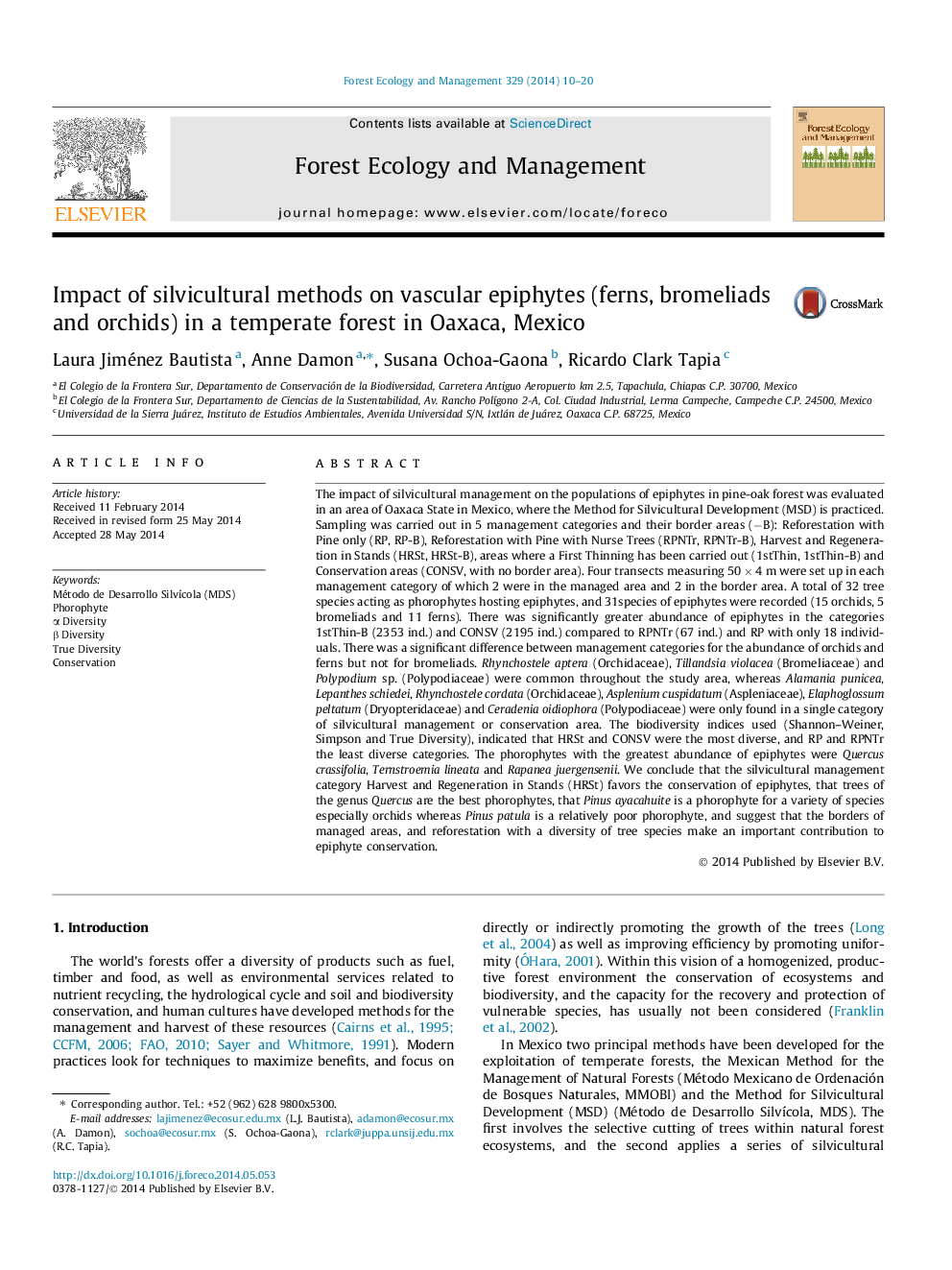| کد مقاله | کد نشریه | سال انتشار | مقاله انگلیسی | نسخه تمام متن |
|---|---|---|---|---|
| 6543401 | 159190 | 2014 | 11 صفحه PDF | دانلود رایگان |
عنوان انگلیسی مقاله ISI
Impact of silvicultural methods on vascular epiphytes (ferns, bromeliads and orchids) in a temperate forest in Oaxaca, Mexico
ترجمه فارسی عنوان
تأثیر روش های کشت و زرع بر اپیفیت های عضلانی (سرخس، برملی ها و ارکیده ها) در یک جنگل معتدل در اواساکا، مکزیک
دانلود مقاله + سفارش ترجمه
دانلود مقاله ISI انگلیسی
رایگان برای ایرانیان
موضوعات مرتبط
علوم زیستی و بیوفناوری
علوم کشاورزی و بیولوژیک
بوم شناسی، تکامل، رفتار و سامانه شناسی
چکیده انگلیسی
The impact of silvicultural management on the populations of epiphytes in pine-oak forest was evaluated in an area of Oaxaca State in Mexico, where the Method for Silvicultural Development (MSD) is practiced. Sampling was carried out in 5 management categories and their border areas (âB): Reforestation with Pine only (RP, RP-B), Reforestation with Pine with Nurse Trees (RPNTr, RPNTr-B), Harvest and Regeneration in Stands (HRSt, HRSt-B), areas where a First Thinning has been carried out (1stThin, 1stThin-B) and Conservation areas (CONSV, with no border area). Four transects measuring 50Â ÃÂ 4Â m were set up in each management category of which 2 were in the managed area and 2 in the border area. A total of 32 tree species acting as phorophytes hosting epiphytes, and 31species of epiphytes were recorded (15 orchids, 5 bromeliads and 11 ferns). There was significantly greater abundance of epiphytes in the categories 1stThin-B (2353 ind.) and CONSV (2195 ind.) compared to RPNTr (67 ind.) and RP with only 18 individuals. There was a significant difference between management categories for the abundance of orchids and ferns but not for bromeliads. Rhynchostele aptera (Orchidaceae), Tillandsia violacea (Bromeliaceae) and Polypodium sp. (Polypodiaceae) were common throughout the study area, whereas Alamania punicea, Lepanthes schiedei, Rhynchostele cordata (Orchidaceae), Asplenium cuspidatum (Aspleniaceae), Elaphoglossum peltatum (Dryopteridaceae) and Ceradenia oidiophora (Polypodiaceae) were only found in a single category of silvicultural management or conservation area. The biodiversity indices used (Shannon-Weiner, Simpson and True Diversity), indicated that HRSt and CONSV were the most diverse, and RP and RPNTr the least diverse categories. The phorophytes with the greatest abundance of epiphytes were Quercus crassifolia, Ternstroemia lineata and Rapanea juergensenii. We conclude that the silvicultural management category Harvest and Regeneration in Stands (HRSt) favors the conservation of epiphytes, that trees of the genus Quercus are the best phorophytes, that Pinus ayacahuite is a phorophyte for a variety of species especially orchids whereas Pinus patula is a relatively poor phorophyte, and suggest that the borders of managed areas, and reforestation with a diversity of tree species make an important contribution to epiphyte conservation.
ناشر
Database: Elsevier - ScienceDirect (ساینس دایرکت)
Journal: Forest Ecology and Management - Volume 329, 1 October 2014, Pages 10-20
Journal: Forest Ecology and Management - Volume 329, 1 October 2014, Pages 10-20
نویسندگان
Laura Jiménez Bautista, Anne Damon, Susana Ochoa-Gaona, Ricardo Clark Tapia,
